Are you looking to take your email marketing to the next level? Then, email segmentation is something you must explore. It is a simple yet powerful strategy to personalize communication and strengthen bonds with subscribers.
By dividing your list into small groups with similar interests and needs, you can deliver tailored content that truly resonates.
This targeted approach maximizes engagement through increased opens, clicks, and conversions. It also boosts satisfaction and loyalty by making subscribers feel valued.
Moreover, segmentation is easy to implement with the right tools and strategies. So, if you want to elevate your email performance, start segmenting today.
Read on to discover how demographic, behavioral, and lifecycle segmentation can work for your business. Learn about tools to make segmentation easy and best practices for success.
Most importantly, see how this personalized approach can elevate your relationships with subscribers.
We are eager to share more about email engagemnt, you too interested? so keep reading below!
So let us start with email segmentation.
What is Email Segmentation?
Just think about sorting your closet into categories for different outfits. Email Segmentation is quite similar -Separating your email list into separate groups based on specific characteristics.
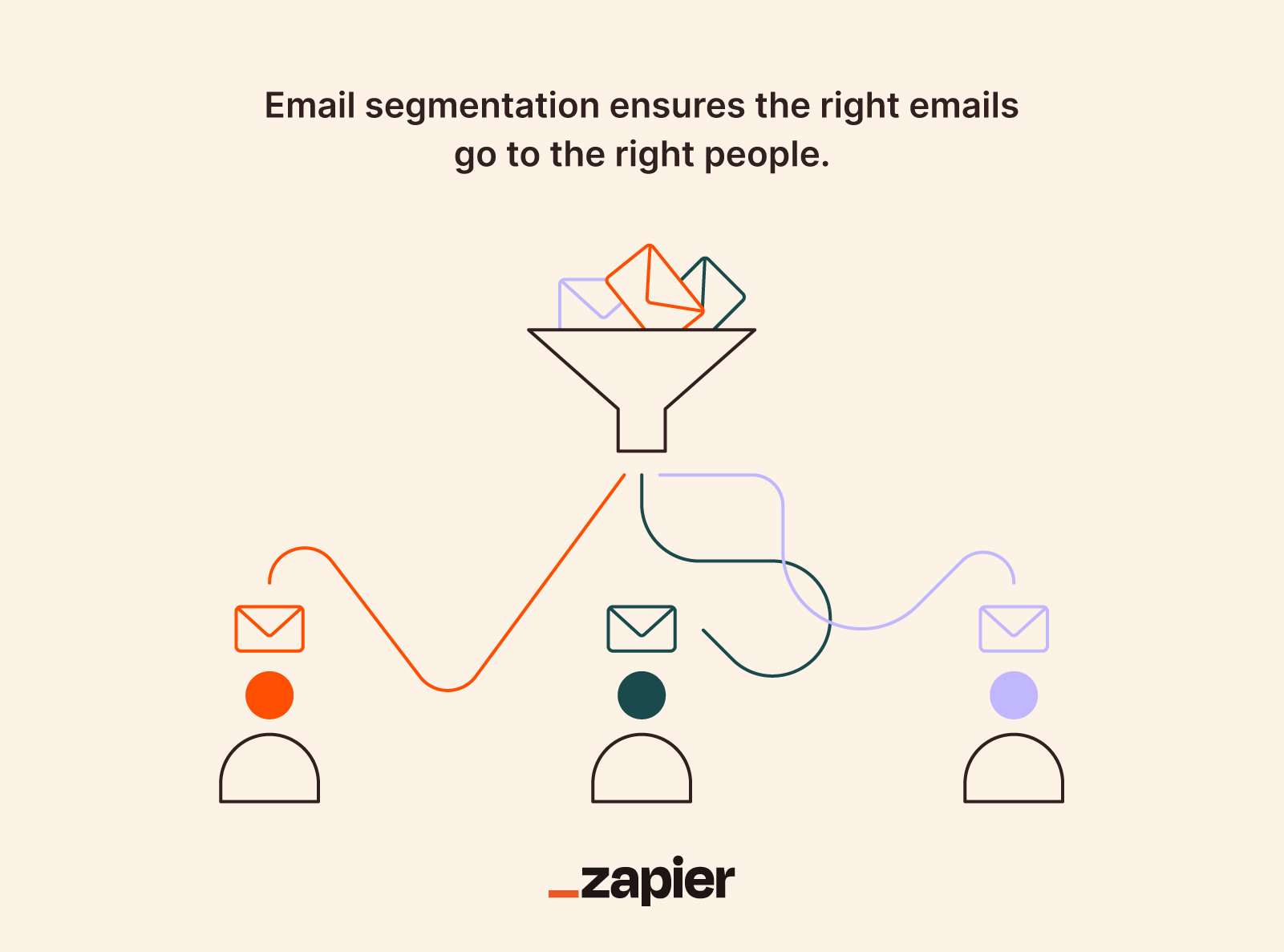
It's easy, and the benefits are substantial. By sending content tailored to each group, your subscribers will love it.
Now let us see some of the perks of email marketing strategies.
The Perks of Email Segmentation for Higher Email Engagement
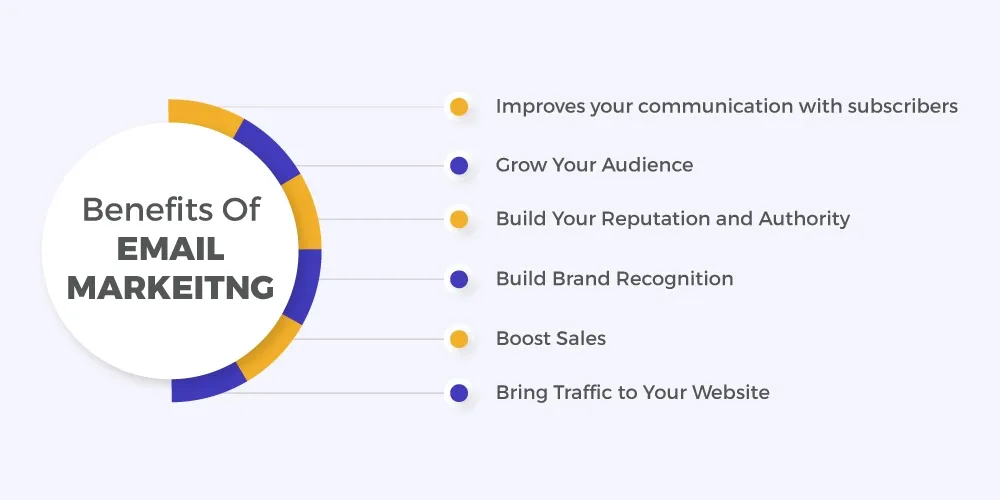
Segmenting your list allows you to focus your messaging and truly connect with your audience.
Keep reading to discover the powerful benefits of targeted emails like increased engagement, higher conversion rates, and stronger customer loyalty.
- Increased Open Rates: Sending emails that resonate with your subscribers' interests increases open rates. It's like receiving a personalized gift - you can't resist it.
Targeted emails capture your subscribers' attention from the start, resulting in increased open rates.
- Higher Click-Through Rates: Segmented emails not only get more opens but also higher click-through rates. When your content aligns with your subscribers' needs, they're more eager to learn more and take action, boosting your click-through rates.
- Improved Conversion Rates: Ultimately, the target of any marketing campaign is conversion. Email segmentation significantly enhances your conversion rates.
Personalized and relevant content addresses your subscribers' pain points, making it more likely to turn leads into paying customers.
- Enhanced Customer Satisfaction and Loyalty: Personalized emails help your subscribers feel valued and appreciated. This, in turn, strengthens their loyalty to your brand.
By segmenting your email list and providing personalized experiences, you build strong relationships, increasing customer satisfaction and long-term loyalty.
Now, after looking into the advantages its time to see various segmentation strategies that can elevate your email marketing.
Exploring Segmentation Strategies for Higher Email Engagement
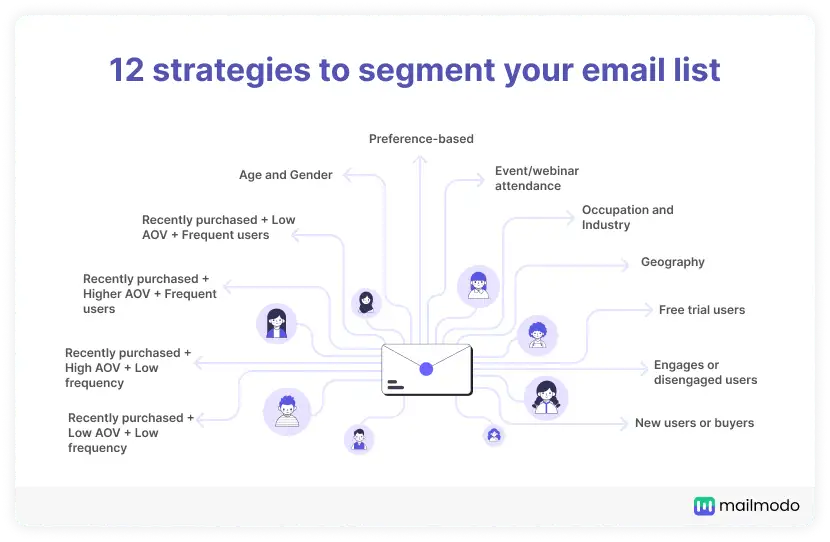
Exploring segmentation strategies for Higher Email Engagement is key. Read on to learn how simple demographic factors like age, gender and location can help you tailor your messaging and truly connect with subscribers.
Read below to explore the Segmentation Strategies.
Demographic Segmentation
Demographic segmentation involves dividing your email list based on various demographic factors.
Knowing the characteristics of your subscribers, such as age, gender, and location, enables you to craft content tailored to their needs and preferences.
- Age: Age plays a vital role in determining preferences and interests. Millennials might respond differently to your emails than baby boomers.
Segmenting your list based on age allows you to create content that resonates with each age group.
- Gender: Gender is another crucial demographic factor to consider. Some products or services might appeal more to one gender than the other.
By segmenting based on gender, you can personalize your emails based on the needs and choices of each group.
- Location: Location-based segmentation is valuable, especially for businesses with a local or regional customer base.
You can create content that aligns with local events, promotions, or offerings by targeting subscribers in specific areas.
Psychographic Segmentation
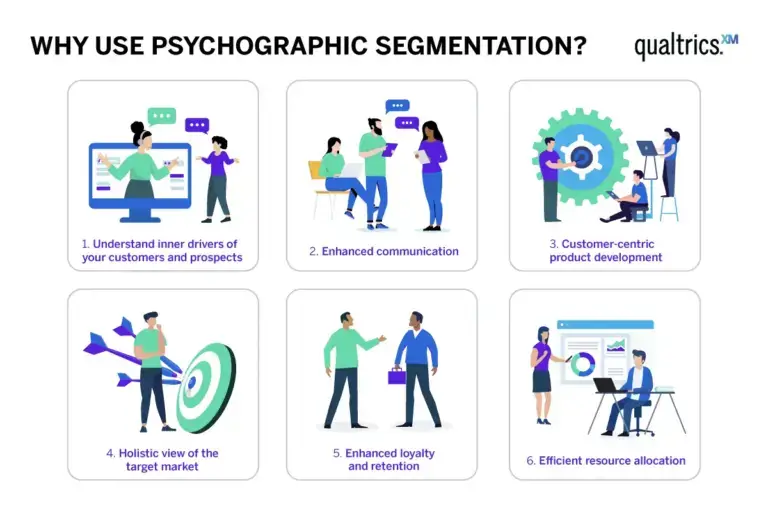
Do you truly understand your subscribers' passions and priorities? Discover how psychographic segmentation can provide valuable insights beyond demographics alone.
Read on to learn how tailoring your messaging based on subscribers' interests and behaviors can deepen connections and drive real results.
- Understanding Your Subscribers on a Deeper Level: Psychographic segmentation focuses on understanding consumer behaviors, interests, preferences, and lifestyles.
Delving into the psychology behind your subscribers allows you to create high-goal and personalized email campaigns.
- Personalized Recommendations: Use psychographic data to provide personalized product recommendations based on subscribers' interests and past behaviors.
Showing them products or services that align with their preferences increases the chances of conversion.
- Tailored Content: Craft email content that resonates with subscribers' values and aspirations. Speak to their emotions, address their pain points, and offer help that aligns with their needs. This personalized approach will boost email engagement and connect your audience more deeply.
- Behavioral Triggers: Leverage psychographic data to create behavioral triggers within your email campaigns. For example, suppose a subscriber frequently purchases a particular type of product.
In that case, you can set up automated emails to follow up with related recommendations or exclusive offers, increasing the likelihood of repeat purchases.
Incorporating psychographic segmentation into your email marketing strategy allows you to create highly engaging campaigns that truly resonate with your subscribers' desires.
Behavioral Segmentation
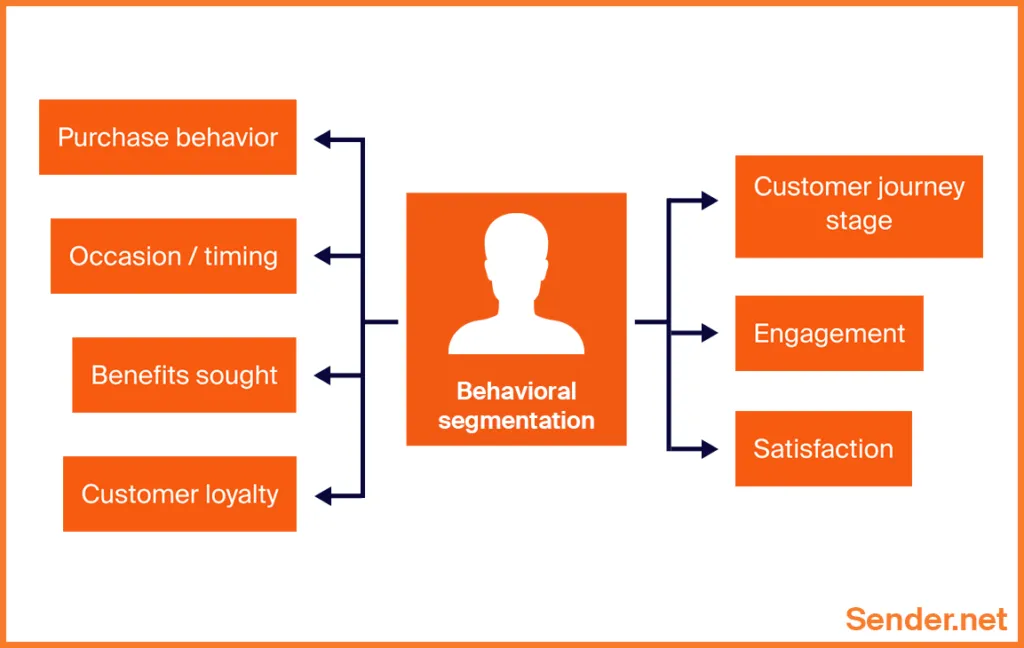
Behavioral segmentation allows you to understand interests and tailor your content for maximum impact.
Keep reading to discover how targeting messages based on engagement patterns can boost results.
Understanding Your Subscribers' Actions
Behavioral segmentation is a plan that involves dividing your email list based on customers' actions and behaviors.
By analyzing how subscribers engage with your email engagement ideas, you can tailor your content to their choices and preferences.
Analyzing Customer Engagement Patterns
It's essential to analyze customer engagement patterns to implement behavioral segmentation effectively.
You can gain insights via email engagement into needs and behaviors by understanding how subscribers interact with your emails, such as open rates, click-through rates, and purchase history.
Suggested Reading:
Personalization and Its Effect on Email Marketing Metrics
Sending Tailored Emails Based on Behavioral Data
Once you have analyzed customer engagement patterns, it's time to send tailored emails based on that data. Here are a few ways you can leverage behavioral segmentation:
- Personalized Recommendations: Use customers' purchase history or browsing behavior to provide personalized product recommendations.
You increase the chances of conversion by suggesting items that align with their interests and past behaviors.
- Abandoned Cart Reminders: If a customer adds items to their cart but still needs to complete the purchase, you can set up automated emails to remind them.
Offering a discount or free shipping can entice them to complete the purchase.
- Reactivation Campaigns: You can send reactivation campaigns for customers who last engaged with your emails a while ago.
These emails aim to reconnect with inactive subscribers and encourage them to re-engage.
By leveraging behavioral segmentation, you can send targeted emails that resonate with subscribers' interests and behaviors, leading to higher engagement and conversion rates.
Lifecycle Segmentation

Learn how lifecycle segmentation can help you better understand your customers' journey with your brand.
Below, we break down the key stages and how to create targeted campaigns for maximum engagement
Categorizing Customers Based on Their Journey
Lifecycle segmentation involves categorizing customers based on different stages of their relationship with your brand.
Understanding these stages is crucial for creating targeted email campaigns that cater to customers' specific needs and encourage them to move through the lifecycle.
Suggested Reading:
5 Killer mistakes to avoid with Email Automation
Creating Targeted Email Campaigns for Each Stage
To maximize engagement and retention, it's essential to create targeted email campaigns for each stage of the customer lifecycle:
- Acquisition Stage: During the acquisition stage, focus on converting leads into first-time customers. Offer incentives, like discounts or freebies, to promote their first purchase.
- Onboarding Stage: Once customers make their first purchase, the onboarding stage begins. Use this opportunity to introduce them to your brand, tell them about your products or services, and provide a seamless and personalized experience.
- Retention Stage: In the retention stage, the target is to keep customers engaged and build long-term relationships. Send exclusive offers, rewards, and relevant content to nurture their loyalty and encourage repeat purchases.
- Reactivation Stage: For customers who have become inactive, implement reactivation campaigns to win them back. Offer incentives, showcase new products, or provide personalized recommendations to reignite their interest.
After looking into the types of segmentations in segmentation strategies for Higher Email Engagement, its time to see the tools and engagement for email engagement.
Segmentation Tools and Strategies
Effective email segmentation is the key to delivering personalized messages that resonate. With the right tools and strategies, you can group your contacts and tailor your communications in a meaningful way.
Keep reading to discover essential segmentation tools and strategies that will help you stand out from the crowd.
Essential Tools for Effective Email Segmentation

Having the right tools at your disposal is essential to achieve effective email segmentation. Here are a few popular tools to consider.
- Customer Relationship Management (CRM) Systems: CRM systems like Salesforce, HubSpot, and Mailchimp offer segmentation features that allow you to create dynamic lists based on customer data, interactions, and preferences.
- Marketing Automation Platforms: Platforms such as Marketo and ActiveCampaign provide advanced segmentation capabilities, allowing you to automate personalized email campaigns based on targeted segments.
Finally, you are at the end of the blog, its time to see the best practices for creating effective segments.
Best Practices for Creating Effective Segments

Mastering audience segmentation is key. With the right insights and strategies, you can engage customers like never before.
Keep discovering the best practices for creating powerful segments that drive real results.
Mastering the Art of Segmentation
Now that you have the tools, it's time to create influential segments that drive engagement. Here are some best practices to keep in mind:
- Use Relevant Data Points: Segmentation works best when you use relevant data points such as demographics, purchase history, browsing behavior, and engagement metrics.
- Avoid Over-segmentation: While segmentation is crucial, be careful to create only a few segments. Over-segmentation can make creating targeted content difficult and maintaining a consistent email schedule.
Conclusion
So, did you find this introduction to email segmentation insightful? Implementing it can take your email marketing success to new heights.
Personalizing your communication through relevant segmentation can strengthen bonds with subscribers and maximize email engagement. Don't wait to see these benefits - start applying strategies discussed here today.
Remember, segmentation is simple when you have the right tools. So get started now on dividing lists and delivering tailored campaigns. With a targeted approach and continual testing, you'll be amazed by the results.
Most of all, it keeps subscribers feeling valued through highly personalized content. This will foster their loyalty and ensure relationships withstand the test of time.
You have the power to elevate your email performance starting right now. We wish you all the best in segmenting your lists and scaling new heights of success!
Frequently Asked Questions (FAQs)
What are the key benefits of using segmentation in email marketing strategies?
Using segmentation in email engagement allows businesses to deliver personalized content, increase customer engagement, improve open and click-through rates, and ultimately drive higher conversion and retention rates, resulting in a more effective and efficient email marketing strategy.
What are some popular segmentation criteria used in email marketing?
Popular segmentation criteria include demographic information, purchase history, customer behavior, geographic location, and engagement level, enabling businesses to target specific customer groups with tailored and relevant content for higher email engagement and conversion rates.
What are the three aspects of a successful email marketing strategy?
The three key aspects of a successful email marketing strategy include audience segmentation, personalized content, and data-driven analysis, enabling businesses to deliver targeted and relevant messages that resonate with subscribers, leading to increased email engagement and conversion rates.
What is the most important KPI for email marketing?
The most important key performance indicator (KPI) for email marketing is the conversion rate, which measures the percentage of subscribers who complete a desired action, such as making a purchase or signing up for a service, indicating the overall effectiveness and success of email campaigns.
What are the best practices to increase email engagement?
Best practices to increase email engagement include creating compelling subject lines, designing visually appealing content, personalizing messages, optimizing send times, and regularly analyzing and refining email campaigns based on performance data, ensuring higher open and click-through rates.



